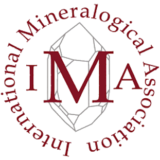The Commission on New Minerals, Nomenclature and Classification (CNMNC) of the International Mineralogical Association (IMA) was formed in July 2006 by a merger between the Commission on New Minerals and Mineral Names (CNMMN) and the Commission on Classification of Minerals, at the request of both commissions. The Chairman has published a paper on this merger in Elements, Vol. 2, p. 388.
The Commission on New Minerals and Mineral Names (CNMMN) was established in 1959 for the purpose of controlling the introduction of new minerals and mineral names, and of rationalising mineral nomenclature. Since that time, the work of the CNMMN has gained overwhelming support from the international mineralogical community. Please consult a review of the Commission activities. An official IMA-CNMNC list of Mineral Names can be accessed on the IMA list of minerals page of the web site.
The CNMNC consists of representatives appointed by national mineralogical bodies, and an executive committee consisting of chairman, two vice-chairmen and secretary, see the list of current members.
The activities of the CNMMN, and its various recommendations for mineral nomenclature, have been widely published (see IMA reports) in a substantial number of mineralogical journals over a number of years.
It must be understood that the CNMNC does not wish to impose an arbitrary set of rigid rules on the mineralogical community, but rather to provide a set of coherent guidelines that provide a reasonably consistent approach to the introduction of new minerals and the application of mineral nomenclature. The CNMNC has a protocol with procedures and guidelines for proposing new minerals and mineral names.
News about the CNMNC and/or updated items on the CNMNC website
November 2024
The CNMNC has established a 75% positive vote threshold for the approval of new minerals, changes in nomenclature, and the formation of mineral groups/supergroups, with the Chair (or the officer in charge) retaining the right to suspend voting based on member feedback.
January 2025
The IMA-CNMNC guidelines for minerals of uncertain origin have been revised based on the 2024 IMA Mediation Committee report. It is crucial to refer to these guidelines when submitting mineral proposals to the CNMNC to eliminate potential issues such as contamination, anthropogenic influences, and fraudulent syntheses.
IMA-CNMNC list of Unamed Minerals
- A system of codification for unnamed minerals was originally published in Can. Mineral., 45 (2007), 983-990.
- Updated lists of unnamed minerals (January 2023) can be viewed here: valid unnamed minerals and invalid unnamed minerals.
These lists were prepared by the IMA-CNMNC Subcommittee on Unnamed Minerals (SUM): Jeffrey de Fourestier, Marco E. Ciriotti and Yang Zhuming.
IMA-CNMNC List of Mineral Names
This list contains names and data for minerals which have been approved, discredited, redefined and renamed and is the new revised master list of all IMA-approved and grandfathered (i.e. inherited from before 1960) minerals.
A new mineral!? What to do?
Researchers finding a phase of which they think that it might be a new mineral are encouraged to use the following procedure in order to get it approved by the IMA-CNMNC.
- Please read carefully the procedures and guidelines of the IMA-CNMNC on the criteria for a new mineral species and the treatment of a new-mineral proposal.
- Please also consult these procedures and guidelines if proposing changes to existing nomenclature.
- For a comprehensive list of key papers addressing mineral-related rules and regulations, refer to IMA reports.
- If the possibility of a new mineral still stands after reading the procedures and guidelines, please download the checklist for new-mineral proposals. Provide the data asked for, as far as possible.
- Send the completed checklist (in electronic format) to the CNMNC chairman.
- Send proposals to change existing nomenclature to the CNMNC vice-chairman

